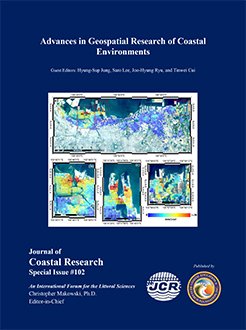Kim, I.; Park, S.-I., and Lee, H.-J., 2020. Structural analysis of a fault-related anticline in the southwestern Gyeonggi Massif, Korea using an unmanned aerial vehicle and field surveys: The role of rejoining splays in a duplex-like structure. In: Jung, H.-S.; Lee, S.; Ryu, J.-H., and Cui, T. (eds.), Advances in Geospatial Research of Coastal Environments. Journal of Coastal Research, Special Issue No. 102, pp. 261-270. Coconut Creek (Florida), ISSN 0749-0208.
In fold and thrust belts, various contractional structures accommodate horizontal shortening and vertical thickening in response to orogenic events. In this study, it was conducted a structural analysis of the Gomseom anticline, exposed along the coast in a part of a Phanerozoic orogenic belt in the southwestern Gyeonggi Massif, on the southern Korean Peninsula. To combat difficulties related to accessing the outcrop under tidal effects, high-resolution unmanned aerial vehicle (UAV) images alongside field data was used. The UAV photography technique allowed easy macro and mesoscale structural mapping and down-plunge projection, thereby enabling the efficient interpretation of the geometric and kinematic features of the Gomseom anticline. In the core of the Gomseom anticline, fault-bounded sheets are vertically stacked and folded, giving rise to a unique structural geometry analogous to duplexes. This duplex-like structure is bounded by a submerged thrust at the base and tightly folded thrust imbrication at the top and defined by intervening shortcut rejoining splays branching from the latter. Taking the kinematics of the sheet-bounding faults and intra-sheet minor faults into account, it was suggested an evolutionary model of the Gomseom anticline in which repeated fault-related folding and sequential propagation of rejoining splays give rise to the duplex-like structure. In the rejoining splay model, displacement on the basal thrust is transferred to a passive-roof thrust without hard links between them. Our result can be evaluated as a possible alternative duplex model that contrasts pre-existing models such as “Boyer-type”, “connecting splay”, and “fold” duplexes. However, further testing of the model is required.





